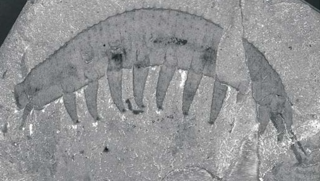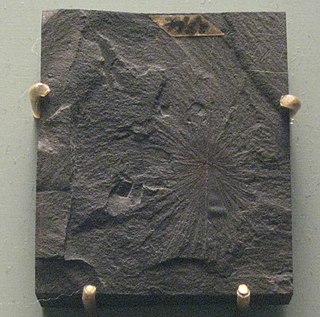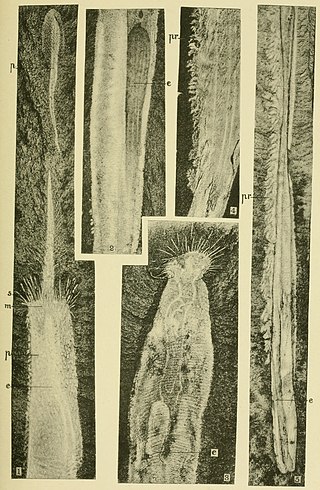
Marrella is an extinct genus of marrellomorph arthropod known from the Middle Cambrian of North America and Asia. It is the most common animal represented in the Burgess Shale of British Columbia, Canada, with tens of thousands of specimens collected. Much rarer remains are also known from deposits in China.

Aysheaia is an extinct genus of soft-bodied lobopodian, known from the Middle Cambrian Burgess Shale of British Columbia, Canada

Ottoia is a stem-group archaeopriapulid worm known from Cambrian fossils. Although priapulid-like worms from various Cambrian deposits are often referred to Ottoia on spurious grounds, the only clear Ottoia macrofossils come from the Burgess Shale of British Columbia, which was deposited 508 million years ago. Microfossils extend the record of Ottoia throughout the Western Canada Sedimentary Basin, from the mid- to late- Cambrian. A few fossil finds are also known from China.

Waptia is an extinct genus of arthropod from the Middle Cambrian of North America. It grew to a length of 6.65 cm (3 in), and had a large bivalved carapace and a segmented body terminating into a pair of tail flaps. It was an active swimmer and likely a predator of soft-bodied prey. It is also one of the oldest animals with direct evidence of brood care. Waptia fieldensis is the only species classified under the genus Waptia, and is known from the Burgess Shale Lagerstätte of British Columbia, Canada. Specimens of Waptia are also known from the Spence Shale of Utah, United States.

Choia is a genus of extinct demosponge ranging from the Cambrian until the Lower Ordovician periods. Fossils of Choia have been found in the Burgess Shale in British Columbia; the Maotianshan shales of China; the Wheeler Shale in Utah; and the Lower Ordovician Fezouata formation. It was first described in 1920 by Charles Doolittle Walcott.

Leanchoilia is a megacheiran arthropod known from Cambrian deposits of the Burgess Shale in Canada and the Chengjiang biota of China.

Scenella is an extinct genus of fossil invertebrate animal which is generally considered to be a mollusc; at various times it has been suggested that this genus belongs with the gastropods, the monoplacophorans, or the helcionellids, although no firm association with any of these classes has been established. An affinity with the hydrozoa has been considered, although some authors oppose this hypothesis. A gastropod affinity is defended on the basis of six pairs of internal muscle scars, whilst the serially-repeated nature of these scars suggests to other authors a monoplacophoran affinity. However the specimens showing this scarring have not been convincingly shown to belong to the genus Scenella. A similarity to the Ediacaran Ovatoscutum has also been drawn.

Chancelloria is a genus of early animals known from the Middle Cambrian Burgess Shale, the Comley limestone, the Wheeler Shale, the Bright Angel Shale and elsewhere. It is named after Chancellor Peak. It was first described in 1920 by Charles Doolittle Walcott, who regarded them as one of the most primitive groups of sponges. However, they are currently thought to be member of the group Chancelloriidae. 178 specimens of Chancelloria are known from the Greater Phyllopod bed, where they comprise 0.34% of the community.

Hurdia is an extinct genus of hurdiid radiodont that lived 505 million years ago during the Cambrian Period. Fossils have been found in North America, China and the Czech Republic.

Eldonia is an extinct soft-bodied cambroernid animal of unknown affinity, best known from the Fossil Ridge outcrops of the Burgess Shale, particularly in the 'Great Eldonia layer' in the Walcott Quarry. In addition to the 550 collected by Walcott, 224 specimens of Eldonia are known from the Greater Phyllopod bed, where they comprise 0.43% of the community. Species also occur in the Chengjiang biota, Siberia, and in Upper Ordovician strata of Morocco.
Cambrorhytium is an enigmatic fossil genus known from the Latham Shale (California), and the Chengjiang (China) and Burgess Shale lagerstätte. 350 specimens of Cambrorhytium are known from the Greater Phyllopod bed, where they comprise 0.7% of the community.
Acrothyra gregaria is a species of gregarious brachiopod known from the Middle Cambrian Burgess Shale. 253 specimens of Acrothyra are known from the Greater Phyllopod bed, where they comprise 0.5% of the community.
Eiffelia is an extinct genus of sponges known from the Middle Cambrian Burgess Shale as well as several Early Cambrian small shelly fossil deposits. It is named after Eiffel Peak, which was itself named after the Eiffel Tower. It was first described in 1920 by Charles Doolittle Walcott. It belongs in the Hexactinellid stem group. 60 specimens of Eiffelia are known from the Greater Phyllopod bed, where they comprise 0.11% of the community.

Halichondrites, sometimes mis-spelt Halicondrites is an extinct genus of sea sponge known from the Middle Cambrian Burgess Shale. 7 specimens of Halichondrites are known from the Greater Phyllopod bed, where they comprise < 0.1% of the community.

Emeraldella is a genus of arthropod known from the Middle Cambrian of North America. The type species E. brocki was described in 1912 from the Burgess Shale. 21 specimens of Emeraldella are known from the Greater Phyllopod bed, where they comprise < 0.1% of the community. A re-study on the species was done in 2012. A second species E. brutoni is known from the Wheeler Shale, which was described in 2011. An additional specimen of E. brutoni was described in 2019, which revealed more of the anatomy. It has been placed as a basal member of the clade Vicissicaudata within Artiopoda, a group of arthropods containing trilobites and their relatives.
Mackenzia is an elongated bag-like animal known from the Middle Cambrian Burgess Shale. It attached directly to hard surfaces, such as brachiopod shells. 14 specimens of Mackenzia are known from the Greater Phyllopod bed, where they comprise <0.1% of the community. Mackenzia was originally described by Charles Walcott in 1911 as a holothurian echinoderm. Later, Mackenzia is thought to be a cnidarian and appears most similar to modern sea anemones.

Louisella is a genus of worm known from the Middle Cambrian Burgess Shale. It was originally described by Charles Walcott in 1911 as a holothurian echinoderm, and represents a senior synonym of Miskoia, which was originally described as an annelid. 48 specimens of Louisella are known from the Greater Phyllopod bed, where they comprise < 0.1% of the community. It has been stated to have palaeoscolecid-like sclerites, though this is not in fact the case.

Mollisonia is an extinct genus of Cambrian arthropod. Species are known from the Burgess Shale, Langston Formation, and Wheeler Shale of North America, as well as the Chengjiang Biota of China. Twenty-one specimens of Mollisonia are known from the Greater Phyllopod bed, where they comprise less than 0.1% of the community. Remains possibly attributable to the genus are also known from the Ordovician Fezouata Formation of Morocco and Bøggild Fjord Formation Greenland. An observation published in 2019 suggests this genus is a basal chelicerate, closer to crown group Chelicerata than members of Habeliida. It is suggested to be closely related to Corcorania, Urokodia, and Thelxiope, which together form the clade Mollisoniida, which are thought to be closely related to Chelicerata.
Leptomitus is a genus of demosponge known from the Middle Cambrian Burgess Shale. Its name is derived from the Greek lept ("slender") and mitos ("thread"), referring to the overall shape of the sponge. 138 specimens of Leptomitus are known from the Greater Phyllopod bed, where they comprise 0.26% of the community.

Pagetia is a genus of small trilobite, assigned to the Eodiscinid family Pagetiidae and which had global distribution during the Middle Cambrian. The genus contains 55 currently recognized species, each with limited spatial and temporal ranges.


















